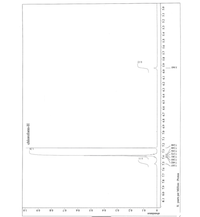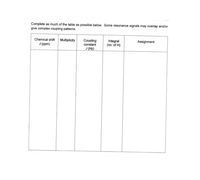
Chemistry
10th Edition
ISBN: 9781305957404
Author: Steven S. Zumdahl, Susan A. Zumdahl, Donald J. DeCoste
Publisher: Cengage Learning
expand_more
expand_more
format_list_bulleted
Concept explainers
Question

Transcribed Image Text:5.945"
7.248
7348
7.356
7372
7.395
LOS L
60
80
9'0
0.5
0.4
0.3
0.7
0.2
abundance
8.1 8.0 7.9 7.8 7.7 7.6 75 74 13 12 7.1 7.0 6.9 6.8 6.7 6.6 6.5 64 63 6.2 6.1 6.0 5.9 5.8 5.7 5.6 5.5 5.4 53 52 5.1 5.0
altaly
X: parts per Million : Proton

Transcribed Image Text:Complete as much of the table as possible below. Some resonance signals may overlap and/or
give complex coupling pattems.
Chemical shift Multiplicity
8 (ppm)
Coupling
constant
J (Hz)
Integral
(no. of H)
Assignment
Expert Solution
This question has been solved!
Explore an expertly crafted, step-by-step solution for a thorough understanding of key concepts.
This is a popular solution
Trending nowThis is a popular solution!
Step by stepSolved in 2 steps with 1 images

Knowledge Booster
Learn more about
Need a deep-dive on the concept behind this application? Look no further. Learn more about this topic, chemistry and related others by exploring similar questions and additional content below.Similar questions
- What molecule is this? Thank youarrow_forward7. Match the type of analysis output to the units appearing on its x-axis. 1H NMR spectrum IR spectrum gas chromatogram mass spectrumarrow_forwardProton nuclear magnetic resonance spectroscopy ('H-NMR) 1.(2) Which of the following statements about proton NMR spectroscopy is FALSE? (Circle/indicate) a) proton nmr requires a strong external magnetic field, and radio frequency transmitter and received b) the energies involved in proton nmr are so large, that the sample is destroyed in the process c) the kinds of information available are chemical shift, integrations, and spin-spin splitting d) the reference standard in proton nmr is tetramethylsilane, chemical shift = 0.0arrow_forward
- For the following structures: (a) find # signals, chem shift ranges, integration, splitting and (b) match the two spectrums.arrow_forwardPlease list all major chemical Shifts, Integration, Splitting, and Conclusion for the 1H-NMR peaks.arrow_forwardNMR data Summary NMR solvent: DMSO-d6 'H NMR: Splitting (Multiplicity) Integration Chemical Shift 9.67 singlet 1H singlet doublet 9.17 7.37 6.72 2.00 1H 2H doublet singlet 2H 3H 1"C NMR: Chemical Shift 167.8 153.3 131.1 121.1 115.1 23.8 15N NMR: Chemical Shift 132.3 Instructions: Step 0: Look at the structure of Tylenol. Determine integration, and splitting you are expecting in the 'H NMR. Step 1: Look at the integration and splitting of the signals in the H NMR spectrum - assign the chemical shift of the protons of the methyl group; make a note which signals in the 'H NMR are due aromatic protons, NH and/or OH. Step 2: Look at the 'HSN HSQC spectrum - Use this spectrum to assign the chemical shifts of the NH proton and the OH proton. Step 3: Look at the 'H1SN HMBC spectrum - Use this spectrum to assign the chemical shifts of the aromatic protons in the 'H NMR. Step 4: Look at the 13C NMR spectrum - Make a note which carbon atoms are aromatic and/or alkyl. Assign the chemical shift of…arrow_forward
- ching and le X A PLQ-PHY2054L.docx - Google X engagenow.com/ilrn/takeAssignment/takeCovalentActivity.do?locator=Dassignment-take ... Translate Open Vellum Course Home [Review Topics] [References] Splitting of a signal in a proton NMR spectrum tells us the number of chemically non-equivalent hydrogens in the immediate vicinity of the hydrogen giving the signal. Predict the number of lines exhibited by hydrogens at the labeled positions in a first-order NMR spectrum. (Make the approximation that all coupling constants are equal.) 1) b a The number of lines exhibited by hydrogen(s) a is The number of lines exhibited by hydrogen(s) b is The number of lines exhibited by hydrogen(s) c is 2) b NH, The number of lines exhibited by hydrogen(s) a is The number of lines exhibited by hydrogen(s) b is The number of lines exhibited by hydrogen(s) c is Darrow_forwardhelparrow_forwardAnalyze the HNMR data attached and state all take aways possible (stating all protons, chemical shift, multiplicity, integration, and coupling constants if necessary)arrow_forward
arrow_back_ios
arrow_forward_ios
Recommended textbooks for you
 ChemistryChemistryISBN:9781305957404Author:Steven S. Zumdahl, Susan A. Zumdahl, Donald J. DeCostePublisher:Cengage Learning
ChemistryChemistryISBN:9781305957404Author:Steven S. Zumdahl, Susan A. Zumdahl, Donald J. DeCostePublisher:Cengage Learning ChemistryChemistryISBN:9781259911156Author:Raymond Chang Dr., Jason Overby ProfessorPublisher:McGraw-Hill Education
ChemistryChemistryISBN:9781259911156Author:Raymond Chang Dr., Jason Overby ProfessorPublisher:McGraw-Hill Education Principles of Instrumental AnalysisChemistryISBN:9781305577213Author:Douglas A. Skoog, F. James Holler, Stanley R. CrouchPublisher:Cengage Learning
Principles of Instrumental AnalysisChemistryISBN:9781305577213Author:Douglas A. Skoog, F. James Holler, Stanley R. CrouchPublisher:Cengage Learning Organic ChemistryChemistryISBN:9780078021558Author:Janice Gorzynski Smith Dr.Publisher:McGraw-Hill Education
Organic ChemistryChemistryISBN:9780078021558Author:Janice Gorzynski Smith Dr.Publisher:McGraw-Hill Education Chemistry: Principles and ReactionsChemistryISBN:9781305079373Author:William L. Masterton, Cecile N. HurleyPublisher:Cengage Learning
Chemistry: Principles and ReactionsChemistryISBN:9781305079373Author:William L. Masterton, Cecile N. HurleyPublisher:Cengage Learning Elementary Principles of Chemical Processes, Bind...ChemistryISBN:9781118431221Author:Richard M. Felder, Ronald W. Rousseau, Lisa G. BullardPublisher:WILEY
Elementary Principles of Chemical Processes, Bind...ChemistryISBN:9781118431221Author:Richard M. Felder, Ronald W. Rousseau, Lisa G. BullardPublisher:WILEY

Chemistry
Chemistry
ISBN:9781305957404
Author:Steven S. Zumdahl, Susan A. Zumdahl, Donald J. DeCoste
Publisher:Cengage Learning

Chemistry
Chemistry
ISBN:9781259911156
Author:Raymond Chang Dr., Jason Overby Professor
Publisher:McGraw-Hill Education

Principles of Instrumental Analysis
Chemistry
ISBN:9781305577213
Author:Douglas A. Skoog, F. James Holler, Stanley R. Crouch
Publisher:Cengage Learning

Organic Chemistry
Chemistry
ISBN:9780078021558
Author:Janice Gorzynski Smith Dr.
Publisher:McGraw-Hill Education

Chemistry: Principles and Reactions
Chemistry
ISBN:9781305079373
Author:William L. Masterton, Cecile N. Hurley
Publisher:Cengage Learning

Elementary Principles of Chemical Processes, Bind...
Chemistry
ISBN:9781118431221
Author:Richard M. Felder, Ronald W. Rousseau, Lisa G. Bullard
Publisher:WILEY